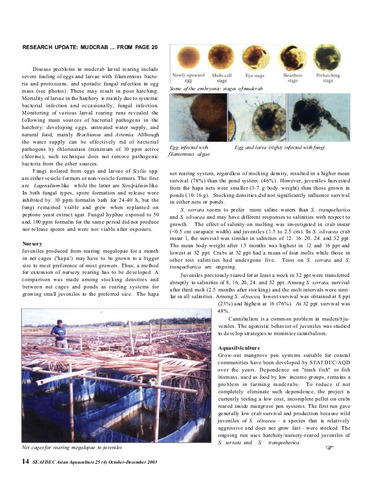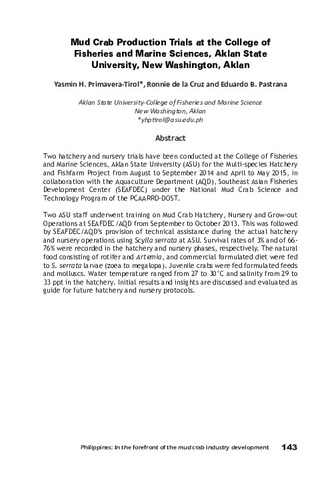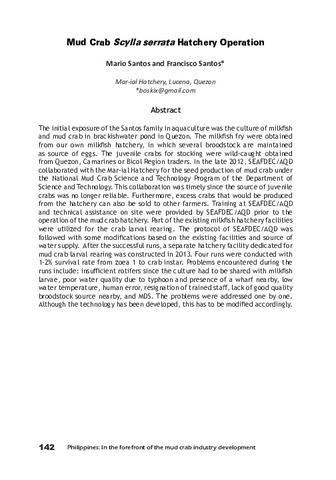Ipakita ang simpleng tala ng item
Haliphthoros spp. from spawned eggs of captive mud crab, Scylla serrata, broodstocks
Share
| dc.contributor.author | Leaño, Eduardo M. | |
| dc.date.accessioned | 2014-01-30T03:45:02Z | |
| dc.date.available | 2014-01-30T03:45:02Z | |
| dc.date.issued | 2002 | |
| dc.identifier.citation | Leaño, E. M. (2002). Haliphthoros spp. from spawned eggs of captive mud crab, Scylla serrata, broodstocks. Fungal Diversity, 9, 93-103. | en |
| dc.identifier.issn | 1560-2745 | |
| dc.identifier.uri | http://hdl.handle.net/10862/1938 | |
| dc.description.abstract | Monitoring of the fungal flora of spawned eggs of captive mud crab, Scylla serrata, was conducted in several hatchery runs at the Aquaculture Department of Southeast Asian Fisheries Development Center in Iloilo, Philippines. Quantification of the egg mycoflora revealed the dominance of oomycetes, particularly Haliphthoros spp. among spawners which aborted their eggs prior to hatching. Two species of Haliphthoros (H. philippinensis and H. milfordensis) were identified from the 24 isolates collected. Haliphthoros milfordensis was the dominant species. Physiological studies on vegetative growth and sporulation of the two species show that H. philippinensis have wider optimal range for salinity and temperature requirements than H. milfordensis, especially in sporulation. The pathogenicity study showed that only H. milfordensis was pathogenic to spawned eggs of S. serrata, while H. philippinensis was not. Infection of S. serrata eggs by H. milfordensis was observed starting at two days after inoculation of zoospores with 2-5% infection rate, reaching up to 10% at five days post-inoculation. | en |
| dc.description.sponsorship | Materials and culture media used in this study were obtained from SEAFDEC AQD funded study (study code Nr-05-F99T). The author thanks E. Borlongan for providing the mud crab egg samples used in this study, S.A. Pedrajas for technical assistance, and E. Quinitio for some information on the larval rearing of mud crabs. | en |
| dc.language.iso | en | en |
| dc.publisher | Springer Verlag | en |
| dc.relation.uri | http://www.fungaldiversity.org/fdp/sfdp/9-7.pdf | |
| dc.subject | Scylla serrata | en |
| dc.subject | Philippines | en |
| dc.subject | Crab eggs | en |
| dc.subject | Oomycetes | en |
| dc.subject | Vegetative growth | en |
| dc.title | Haliphthoros spp. from spawned eggs of captive mud crab, Scylla serrata, broodstocks | en |
| dc.type | Article | en |
| dc.citation.volume | 9 | |
| dc.citation.spage | 93 | |
| dc.citation.epage | 103 | |
| dc.citation.journalTitle | Fungal Diversity | en |
| dc.subject.asfa | breeding stock | en |
| dc.subject.asfa | eggs | en |
| dc.subject.asfa | fungal diseases | en |
| dc.subject.asfa | sporogenesis | en |
| dc.subject.asfa | sporulation | en |
| dc.identifier.essn | 1878-9129 | |
| dc.subject.scientificName | Haliphthoros milfordensis | en |
| dc.subject.scientificName | Haliphthoros philippinensis | en |
| dc.subject.scientificName | Scylla serrata | en |
| dc.subject.scientificName | Haliphthoros | en |
Mga file sa item na ito
| Mga file | Sukat | Format | Tingnan |
|---|
Lumilitaw ang item na ito sa sumusunod na (mga) Koleksyon
-
AQD Journal Articles [1249]
These papers were contributed by AQD staff to various national and international journals



